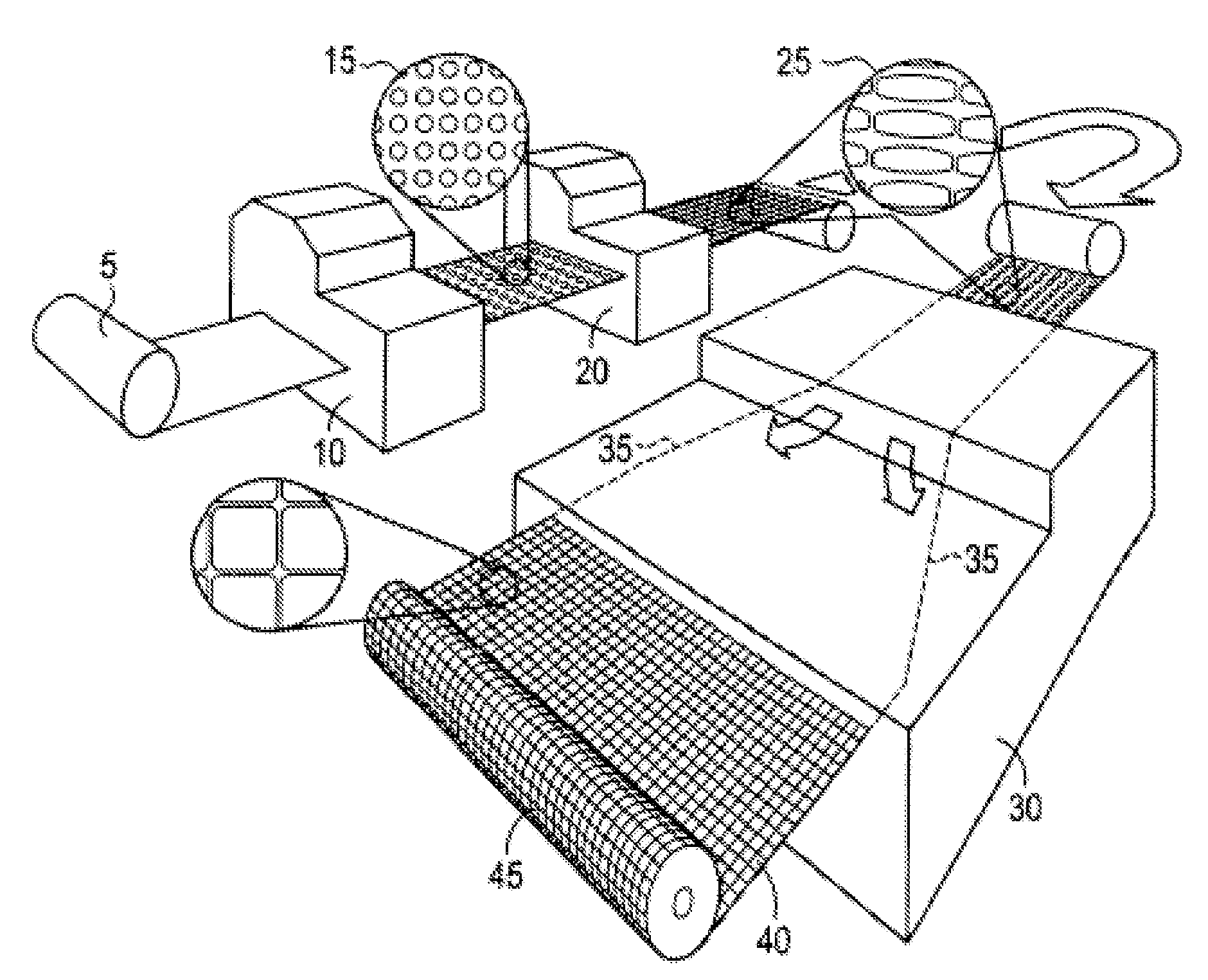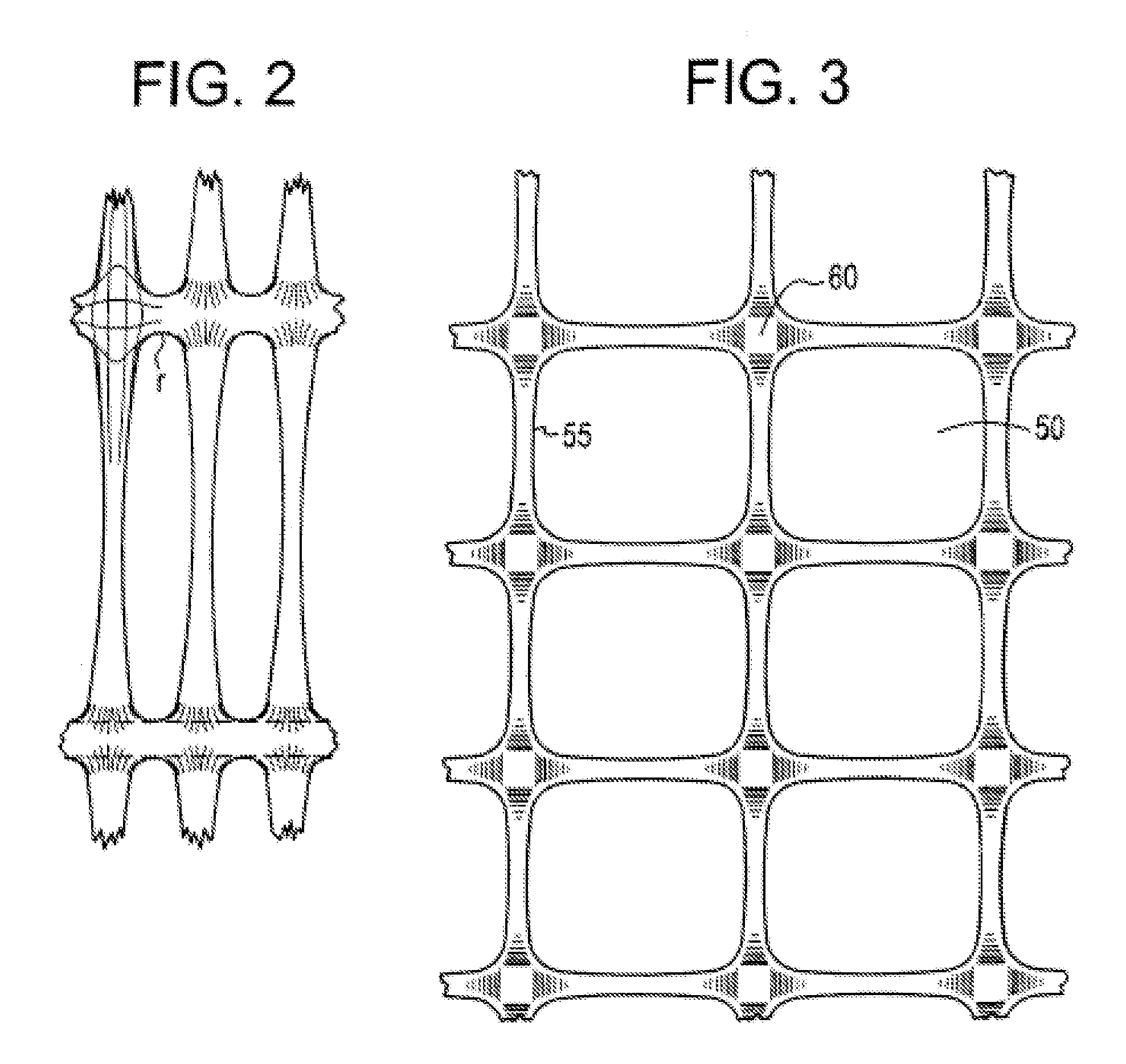Extruded polypropylene sheets containing beta spherulites
a polypropylene and beta spherulite technology, applied in the field of betanucleation concentrates, can solve the problems of inefficient use of materials, low strength of nodes in the central region, and inability to meet the needs of customers, so as to achieve the effect of less expensive and more efficien
- Summary
- Abstract
- Description
- Claims
- Application Information
AI Technical Summary
Benefits of technology
Problems solved by technology
Method used
Image
Examples
example 1
Production of Five Different Extruded Sheet Samples and Their Properties
[0118]Sample 1 was made using 100% of the PRO-FAX 7823, which is a polypropylene homopolymer produced by Basell Polyolefins, with a melt flow rate of about 0.7 g / 10 min. A beta nucleant or carbon black concentrate was not included in Sample 1. The line speed and roll gap nip were set to produce a final sheet thickness of 4.5 mm. The line speed was 3.25 meters / minute, and the final sheet width after the edges were trimmed off was 1.0 meter.
[0119]Sample 2 was made under the same processing conditions as Sample 1, except 2.68% of the Q-dye concentrate was introduced into the feed, resulting in a final sheet that contained about 12 ppm of the Q-dye. This sheet had a light pink color.
[0120]Sample 3 was made under the same processing conditions as Sample 1, except that 3% of a carbon black concentrate was introduced into the feed along with 2.68% of the Q-dye concentrate. This sheet had a uniform black appearance.
[012...
example 2
Comparison of the Properties of Final Net or Grid Materials formed using Samples 1 and 2
[0130]The sheet sample from Sample 1 would not orient under these conditions and tore in the stenter oven. The temperatures were gradually raised until the sheet could be successfully oriented in both directions. It is believed that the sheet was not heating up sufficiently in the ovens due to the fact that it did not contain any carbon black. The final set temperature of the rolls during the MD portion of the orientation was 153° C., which is about 7° C. higher than that which is typically used for orienting carbon black containing sheets.
[0131]The sheet sample of Sample 2 was also biaxially oriented under the same conditions as that used to orient the sheet of Sample 1. When the sheet sample of Sample 2 exited the MD orientation it had a distinctly different appearance from the sheet sample of Sample 1 with respect to both the shape of the holes and the color of the oriented MD strands. The el...
example 3
Comparison of the Properties of Final Net or Grid Materials formed using Samples 3, 4, 5, and 6
[0135]The carbon black containing sheet formed using Samples 3, 4, and 5 were biaxially stretched after having the same pattern of holes punched into them as was punched into Samples 1 and 2. Prior to stretching the Sample 3 sheet, a standard carbon black containing sheet (“Sample 6”) with a thickness of 4.5 mm with no Q-dye was stretched. The MD roll temperatures were set at 150° C. for stretching all of these sheet samples. The final biaxial grid made from Sample 6 had distinct raised humps at the node junction points, whereas the biaxial grids made from the other beta nucleated sheet samples only had a minor thickening in the node region. The sheet dimensions of these different products are listed in Table 3.
[0136]The density of the strands in the MD oriented web produced from the Sample 3 and Sample 6 sheets were 0.876 g / cm3 and 0.911 g / cm3, respectively. This results in a density redu...
PUM
| Property | Measurement | Unit |
|---|---|---|
| elongation | aaaaa | aaaaa |
| elongation | aaaaa | aaaaa |
| elongation | aaaaa | aaaaa |
Abstract
Description
Claims
Application Information
 Login to View More
Login to View More - R&D
- Intellectual Property
- Life Sciences
- Materials
- Tech Scout
- Unparalleled Data Quality
- Higher Quality Content
- 60% Fewer Hallucinations
Browse by: Latest US Patents, China's latest patents, Technical Efficacy Thesaurus, Application Domain, Technology Topic, Popular Technical Reports.
© 2025 PatSnap. All rights reserved.Legal|Privacy policy|Modern Slavery Act Transparency Statement|Sitemap|About US| Contact US: help@patsnap.com



